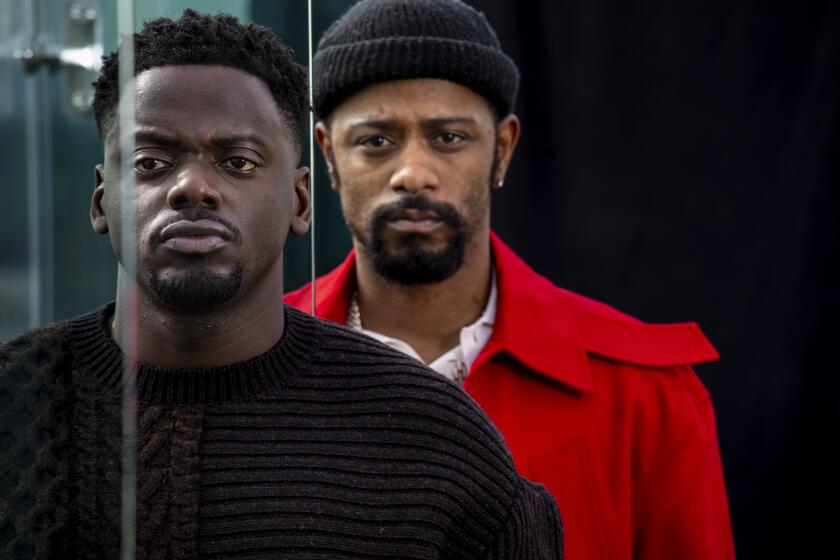‘Judas’ cinematographer becomes invisible man to unobtrusively catch the action
- Share via
At 4:45 a.m. on Dec. 4, 1969, law enforcement raided the apartment of Illinois Black Panther Party Chairman Fred Hampton in Chicago. Among the police, who fired roughly 100 rounds, two were injured. Among the Panthers, who fired one shot in return, seven were charged with attempted murder. Four Panthers were critically wounded; two were killed — one was Hampton.
The raid constitutes the climactic moment in Shaka King’s “Judas and the Black Messiah,” nominated for six Oscars, including best picture and cinematography for veteran director of photography Sean Bobbitt. “It is the single most expensive shot in the show,” he says of a vertical view that travels the layout of the apartment, room to room as the police shoot the occupants in their sleep. “Shaka wanted the world to see Fred Hampton had been shot at through the walls. There had been no effort to come in and arrest anyone.”
The motion-control arm on which the camera is vertically mounted is programmed to repeat its path exactly, take after take. Bobbitt and his team did four passes in all, including one with actors being filmed during the shooting and another with pyrotechnics only. In postproduction, all four passes were married into a single shot of explosive violence.
Set in 1960s Chicago, the historical drama tells the true story of Hampton and Bill O’Neal, the FBI informant who was instrumental in his undoing. The actors who play them, Daniel Kaluuya and LaKeith Stanfield, were Oscar-nominated for their performances.
The ‘Judas and the Black Messiah’ actors talk about their early years, their love of the craft and their appreciation of slain Black Panther leader Fred Hampton, who is at the heart of their film.
“One of the reasons I was drawn to the film to begin with is that that’s happening all the time,” Bobbitt says of the killing of Hampton as he slept in bed. “The scale and number of Black men, women and children who’ve been shot by police, that has shocked me, and it’s shocked the world.”
During preproduction, Bobbitt pored through photos of the period, particularly color images captured in a slightly faded Kodachrome and Ektachrome, characterized by high contrast and vivid primary colors. A predominant hue in the movie’s palette is the cool green that covers the walls of the Panthers’ Chicago headquarters.
“A number of those places actually had those greens in them,” says Bobbitt, who scouted locations in Cleveland, where the film was shot. “Darker flesh tones against a green, it actually can be very flattering.”
A significant portion of the film takes place in the car given to O’Neal by his FBI contact, Roy Mitchell (Jesse Plemons). With limited natural light, car interiors represent a particular challenge, especially at night. Luckily, models from the 1960s are roomy, allowing space for lights if needed. And Bobbitt happily found that the latitude and color detail in the Arri Alexa LF camera could handle the sparse lighting.
Frequently the camera is mounted on a service tray outside the car, looking in. But in one shot, the car pulls to a stop and, after some dialogue, it takes off while the camera stays behind. The trick was to detach the camera from the tray without any noticeable shake while filming. Bobbitt and his team brainstormed electromagnetic contacts that could be deactivated to free the camera on cue among other esoteric techniques.

In the end, they settled on a standard quick-release plate, detaching the camera in the usual way. “As the Panthers get in and the car shakes naturally, we released the clip. So you don’t see the transition to handheld after they pull away.”
When the audience is first introduced to O’Neal, he is posing as a cop and tries to shake down a barroom full of gangsters. Coverage includes a continuous Steadicam shot that begins on the street and follows him into the bar where the dramatic ensemble scene plays out, rising in tension as the gangsters realize he’s not a cop.
What appears to be a complicated mise-en-scène one-take was actually pretty simple, according to Bobbitt, whose years working in documentary filmmaking have helped him hone his work in such dramas as “12 Years a Slave,” directed by his frequent collaborator Steve McQueen.
“There are tricks to making yourself invisible in a room,” he says, smiling as the day winds down on his houseboat on the Thames, the perfect place to self-isolate. “You take yourself out of the equation so the actors don’t have to think about it. To do that, you have to show how much you respect them, and they respect you in return. It’s always a two-way street.”
Bobbitt, who was born in Corpus Christi, Texas, grew up in the UK but attended Santa Clara University. There he studied literature and philosophy, which somehow led to producing and directing television.
“I always thought I’d be a movie writer-director, but not a cinematographer. I didn’t even know what a cinematographer was. But circumstances have taken me down another road, and I literally woke up one day, and I was like, ‘Oh, I’m actually in the right job.’”
More to Read
From the Oscars to the Emmys.
Get the Envelope newsletter for exclusive awards season coverage, behind-the-scenes stories from the Envelope podcast and columnist Glenn Whipp’s must-read analysis.
You may occasionally receive promotional content from the Los Angeles Times.











